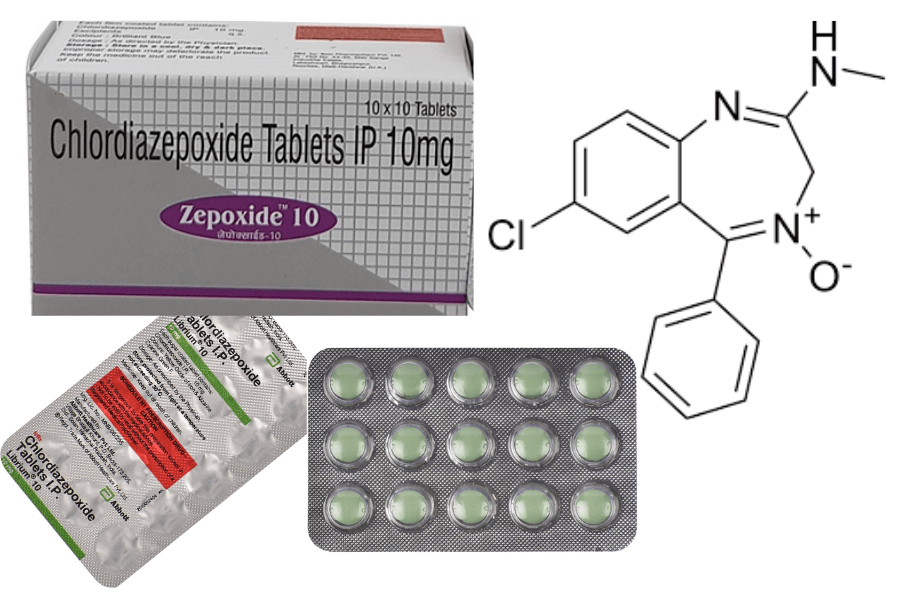Table of contents:
Chlordiazepoxide, trade name Librium, is the prototype of benzodiazepines found on the market as a painkiller/tranquilizer. Chlordiazepoxide is linked to dependency by the user, as per observation.

What is Chlordiazepoxid
Chlordiazepoxide is the first of the benzodiazepine class of drugs to be synthesized in the mid-1950s with a noted calming effect. The sedative, tranquil properties of Chlordiazepoxide are utilized in the management of drug intoxication (alcoholism), anxiety disorder, and pre-op anxiety.
The Librium capsule manual, published by the FDA, contains prescription guidelines for the use of Librium. Other brands of chlordiazepoxide are: Libritabs, poxi, and Mitran. Some notes streets names include: sleeping pills, tranks, downers, and candy.
The United Nations Convention on Psychotropic Substances of 1971 describes chlordiazepoxide as a schedule IV controlled drug.
Indications for Use
Chlordiazepoxide as a prescription drug is recommended for:
After an extensive review of benzodiazepines, the Commitee on the Review of Medicines concluded that the drug loses the ability to promote sleep within 3-14 days of continued use due to tolerance buildup.
Chlordiazepoxide Analogs
Drugs with a similar physical structure to chlordiazepoxide are referred to as the “analog” of said drug. The use of these analogs depends on the desired effect. This table describes the best available chlordiazepoxide analogs based on their effect:
| Alcohol withdrawal | Anxiety Management |
| Valium | Lorazepam |
| Baclofen | Clonazepam |
| Tranxene | Xanax |
The Effects of Chlordiazepoxide Abuse
The oral intake of Librium blocks brain signals and decreases activities of the nerve cells. This mechanism can cause severe dependence on the drug. Chlordiazepoxide intake can also be done by crushing and snorting. Effects can be described as either short (2-4 weeks of abuse) or long (over 4 weeks of abuse) term.
Short-terms Effects:
Long-terms Effects:
Symptoms and Signs of Chlordiazepoxide Use
When an individual shows visible signs of abuse, helping them recover becomes an important priority.
Physical Symptoms
The brain adapts to the presence of Chlordiazepoxide which leads to drug dependency; signs including dry mouth and constipation may arise. Withdrawal symptoms will likely set in if Librium is not taken. Combining the drug with other drugs (polydrug abuse) to get synergic action.(this previous sentence is a little confusing, consider removing or clarifying which drug) Chlordiazepoxide overdose occurs because of heightened drug tolerance.
Psychological Symptoms:
Behavioral Symptoms:
Chlordiazepoxide Treatment Options
Recovery from Chlordiazepoxide dependency is possible.
Medical Treatment for Chlordiazepoxide Addiction
The severe dependency caused by Librum is a cause for concern during rehabilitation. The good news is that complete recovery is possible. A multidimensional approach involving personalization treatment, group therapy, counseling, and medication assistance is employed in Librium addiction treatment.
Inpatient Treatment vs. Outpatient Treatment for Chlordiazepoxide Addiction
During inpatient treatment, the drug-dependent person is admitted into our rehabilitation facility. We provide daily assistance along with complete expert medical supervision. Withdrawal symptoms are closely observed and addressed. While in outpatient treatment, the drug-dependent person does not stay in the rehabilitation facility, but will periodically visit. Outpatient treatment is recommended when there is little to moderate involvement in Librium.
Process and Stages of Chlordiazepoxide Addiction Treatment in VipVorobjev Clinic
Recovery from Chlordiazepoxide dependency is possible.
| 1. Treatment initiation stage: | This is the approach to a rehabilitation center for professional assistance to resolve drug abuse problems, either by the drug-dependent person, or by concerned family members. |
| 2. Maintenance stage: | This is the stage of detoxification with the tapering technique (a gradual reduction of the dosage of Librium to enable complete discontinuation) and the use of multidisciplinary experts to help the drug user overcome addiction. |
| 3. Advance recovery: | The goal of this stage is to attain a Librium-free life by acquiring the necessary coping skills (responsibility, Librium rejection, conversation, and capability to be emotional intelligence) to prevent relapse to drug abuse. |
Diagnosis of Chlordiazepoxide Addiction
Assessing the level of Chlordiazepoxide dependency is a critical step in the treatment of abuse. Available tests are as follows:
Chlordiazepoxide Detoxification Treatment
Librium withdrawal treatment is a weaning process to enable recovery from drug hooks. Detoxification should be carefully monitored by a medical expert. A sudden and complete drop in the use of Librium can have fatal consequences. Detoxifiation includes a process known as “tapering off”. Tapering off is the gradual reduction in the dose of medication to enable discontinuation. Librium is gradually reduced until there is no longer a need for use. This process minimizes withdrawal effects and allows the body to adjust to the weaning process. This method is recommended by medical professions as there are no “quick fix” methods. The different forms of tapering are:
An effective detoxification program ensures safe and comfortable discontinued use of Librium. Further treatment options like aftercare and follow-up should be given to the patient as detoxification does not provide a total cure.
The Average Length of Chlordiazepoxide Treatment
The length of Chlordiazepoxide treatment includes many factors such as age, genetic makeup, body mass index (BMI), existing health conditions, duration of abuse, and the dose of abuse.. Length of stay should be tailored to each individual.
Effectiveness of Treatment for Chlordiazepoxide Addiction
Librium drug treatment is designed to assist drug users in getting rid of drugs and reclaiming their lives; results have shown this is possible. Successful recovery is an indication that Librium overdose treatment is effective. Relapse prevention programs are put in place to further assist the drug users during long-term Librum treatment.
Cost of Chlordiazepoxide Addiction Treatment
Cost varies from 2,700 €.
Doctors
Our doctors have successful experience in treating addictions. The clinic employs psychiatrists, addiction specialists, resuscitators, psychologists and physical therapists to help you overcome addiction and start a new life.
Patents and Certificates
We are DAACC (Drug, Alcohol, and Addiction Counselor Certified)). Certified and registered addiction specialists will assist you in breaking the cycle of drug abuse.

